Unilever Case Study: Project Report on Workforce Transformation
VerifiedAdded on 2023/06/18
|20
|3698
|423
Report
AI Summary
This report provides an analysis of workforce transformation practices, focusing on attracting and retaining talent within Unilever. It begins by outlining the aims and objectives of the research, which centers on understanding workforce transformation in small to medium-sized businesses, identifying challenges in managing this transformation at Unilever, and formulating strategies to maximize its effectiveness. The report details the project management plan, including time, cost, quality, communication, scope, risk, and resource considerations. A work breakdown structure and Gantt chart are used to manage project activities. The research methodology employs both qualitative and quantitative methods, utilizing primary data collected through questionnaires and secondary data from articles and journals. The findings from the questionnaire, involving 30 respondents, reveal insights into awareness of workforce transformation, its role in organizations, suitable strategies for Unilever, long-term effects on productivity, and challenges faced during implementation. The report concludes with recommendations and a reflective discussion on the research process.
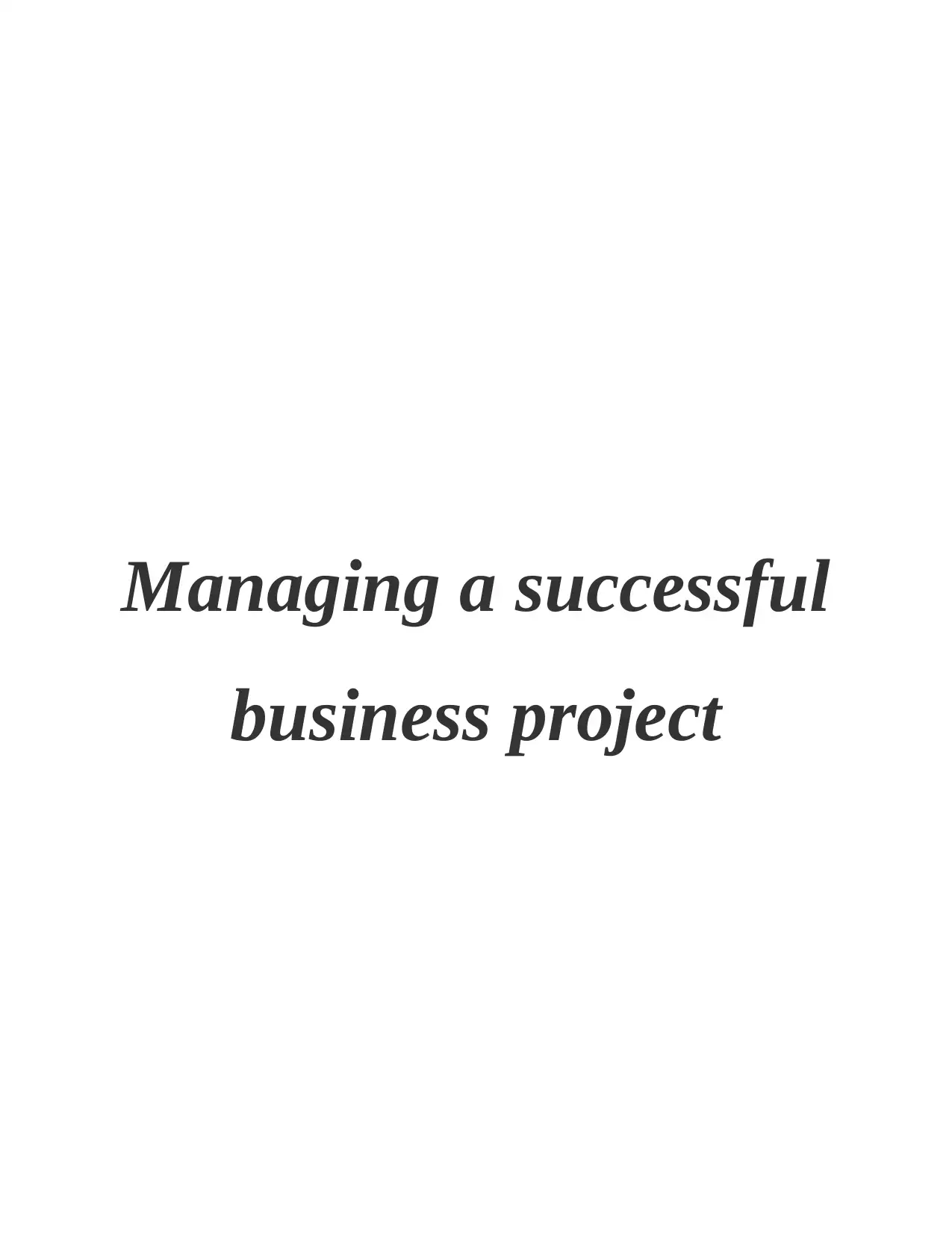
Managing a successful
business project
business project
Paraphrase This Document
Need a fresh take? Get an instant paraphrase of this document with our AI Paraphraser
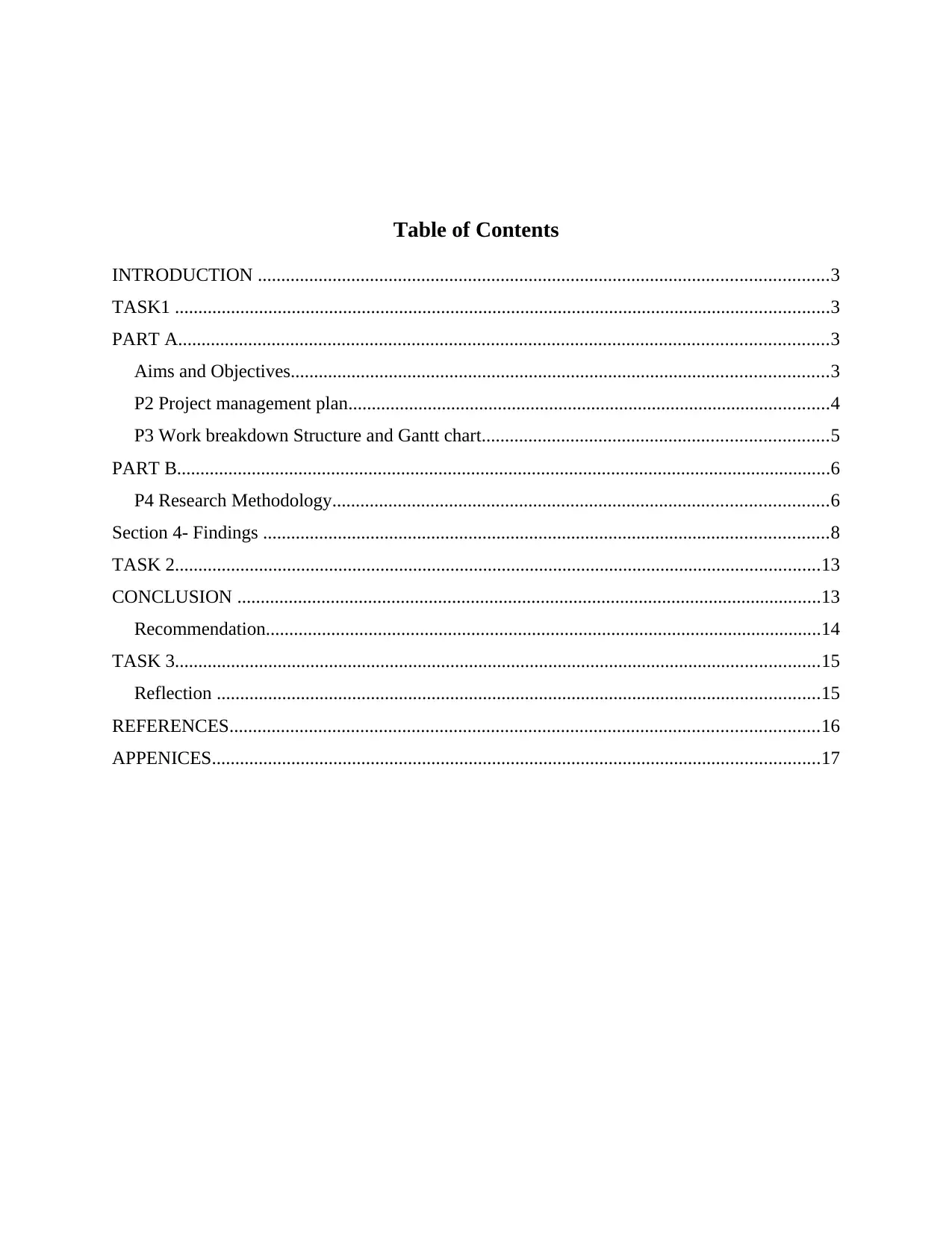
Table of Contents
INTRODUCTION ..........................................................................................................................3
TASK1 ............................................................................................................................................3
PART A...........................................................................................................................................3
Aims and Objectives...................................................................................................................3
P2 Project management plan.......................................................................................................4
P3 Work breakdown Structure and Gantt chart..........................................................................5
PART B............................................................................................................................................6
P4 Research Methodology..........................................................................................................6
Section 4- Findings .........................................................................................................................8
TASK 2..........................................................................................................................................13
CONCLUSION .............................................................................................................................13
Recommendation.......................................................................................................................14
TASK 3..........................................................................................................................................15
Reflection .................................................................................................................................15
REFERENCES..............................................................................................................................16
APPENICES..................................................................................................................................17
INTRODUCTION ..........................................................................................................................3
TASK1 ............................................................................................................................................3
PART A...........................................................................................................................................3
Aims and Objectives...................................................................................................................3
P2 Project management plan.......................................................................................................4
P3 Work breakdown Structure and Gantt chart..........................................................................5
PART B............................................................................................................................................6
P4 Research Methodology..........................................................................................................6
Section 4- Findings .........................................................................................................................8
TASK 2..........................................................................................................................................13
CONCLUSION .............................................................................................................................13
Recommendation.......................................................................................................................14
TASK 3..........................................................................................................................................15
Reflection .................................................................................................................................15
REFERENCES..............................................................................................................................16
APPENICES..................................................................................................................................17
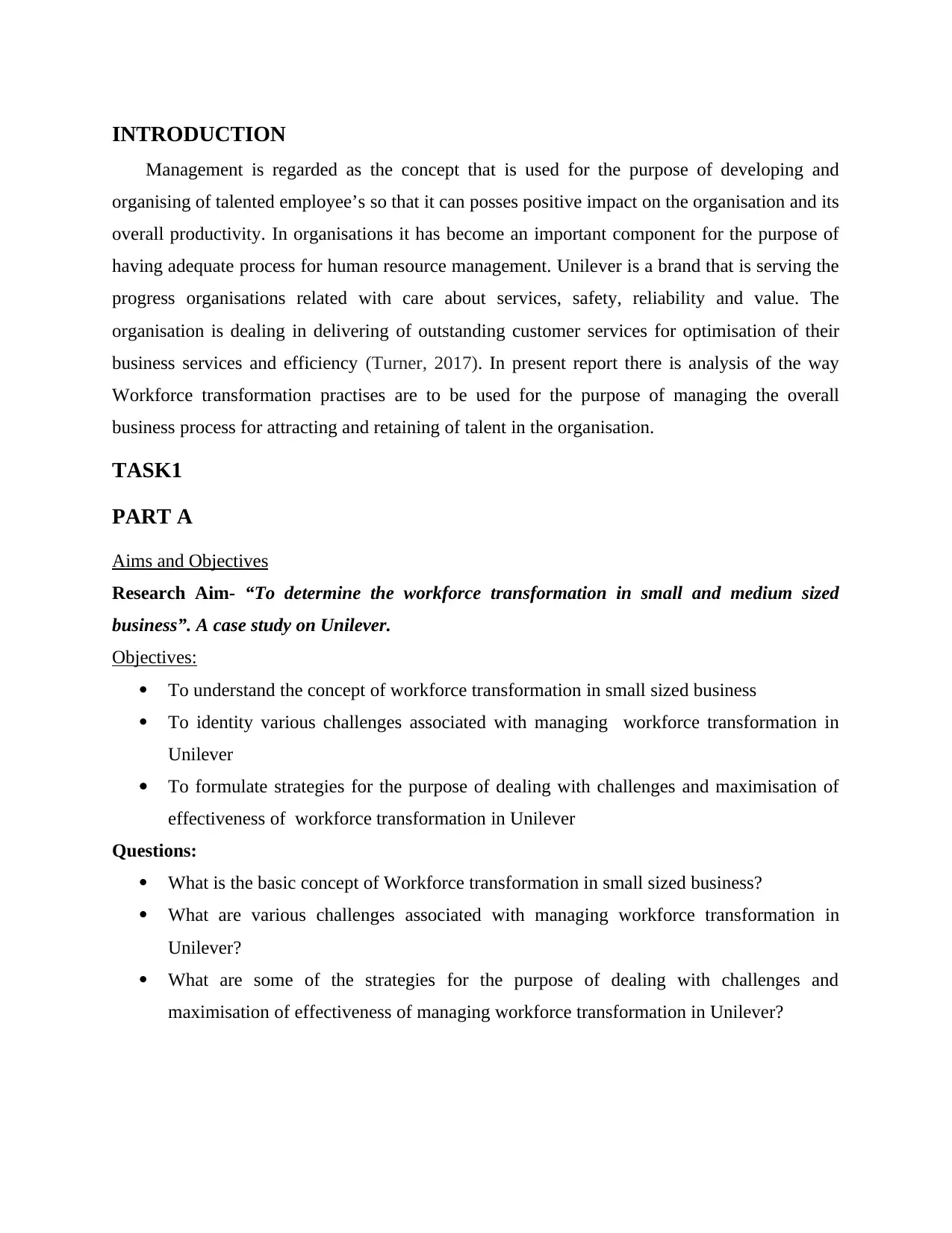
INTRODUCTION
Management is regarded as the concept that is used for the purpose of developing and
organising of talented employee’s so that it can posses positive impact on the organisation and its
overall productivity. In organisations it has become an important component for the purpose of
having adequate process for human resource management. Unilever is a brand that is serving the
progress organisations related with care about services, safety, reliability and value. The
organisation is dealing in delivering of outstanding customer services for optimisation of their
business services and efficiency (Turner, 2017). In present report there is analysis of the way
Workforce transformation practises are to be used for the purpose of managing the overall
business process for attracting and retaining of talent in the organisation.
TASK1
PART A
Aims and Objectives
Research Aim- “To determine the workforce transformation in small and medium sized
business”. A case study on Unilever.
Objectives:
To understand the concept of workforce transformation in small sized business
To identity various challenges associated with managing workforce transformation in
Unilever
To formulate strategies for the purpose of dealing with challenges and maximisation of
effectiveness of workforce transformation in Unilever
Questions:
What is the basic concept of Workforce transformation in small sized business?
What are various challenges associated with managing workforce transformation in
Unilever?
What are some of the strategies for the purpose of dealing with challenges and
maximisation of effectiveness of managing workforce transformation in Unilever?
Management is regarded as the concept that is used for the purpose of developing and
organising of talented employee’s so that it can posses positive impact on the organisation and its
overall productivity. In organisations it has become an important component for the purpose of
having adequate process for human resource management. Unilever is a brand that is serving the
progress organisations related with care about services, safety, reliability and value. The
organisation is dealing in delivering of outstanding customer services for optimisation of their
business services and efficiency (Turner, 2017). In present report there is analysis of the way
Workforce transformation practises are to be used for the purpose of managing the overall
business process for attracting and retaining of talent in the organisation.
TASK1
PART A
Aims and Objectives
Research Aim- “To determine the workforce transformation in small and medium sized
business”. A case study on Unilever.
Objectives:
To understand the concept of workforce transformation in small sized business
To identity various challenges associated with managing workforce transformation in
Unilever
To formulate strategies for the purpose of dealing with challenges and maximisation of
effectiveness of workforce transformation in Unilever
Questions:
What is the basic concept of Workforce transformation in small sized business?
What are various challenges associated with managing workforce transformation in
Unilever?
What are some of the strategies for the purpose of dealing with challenges and
maximisation of effectiveness of managing workforce transformation in Unilever?
⊘ This is a preview!⊘
Do you want full access?
Subscribe today to unlock all pages.

Trusted by 1+ million students worldwide
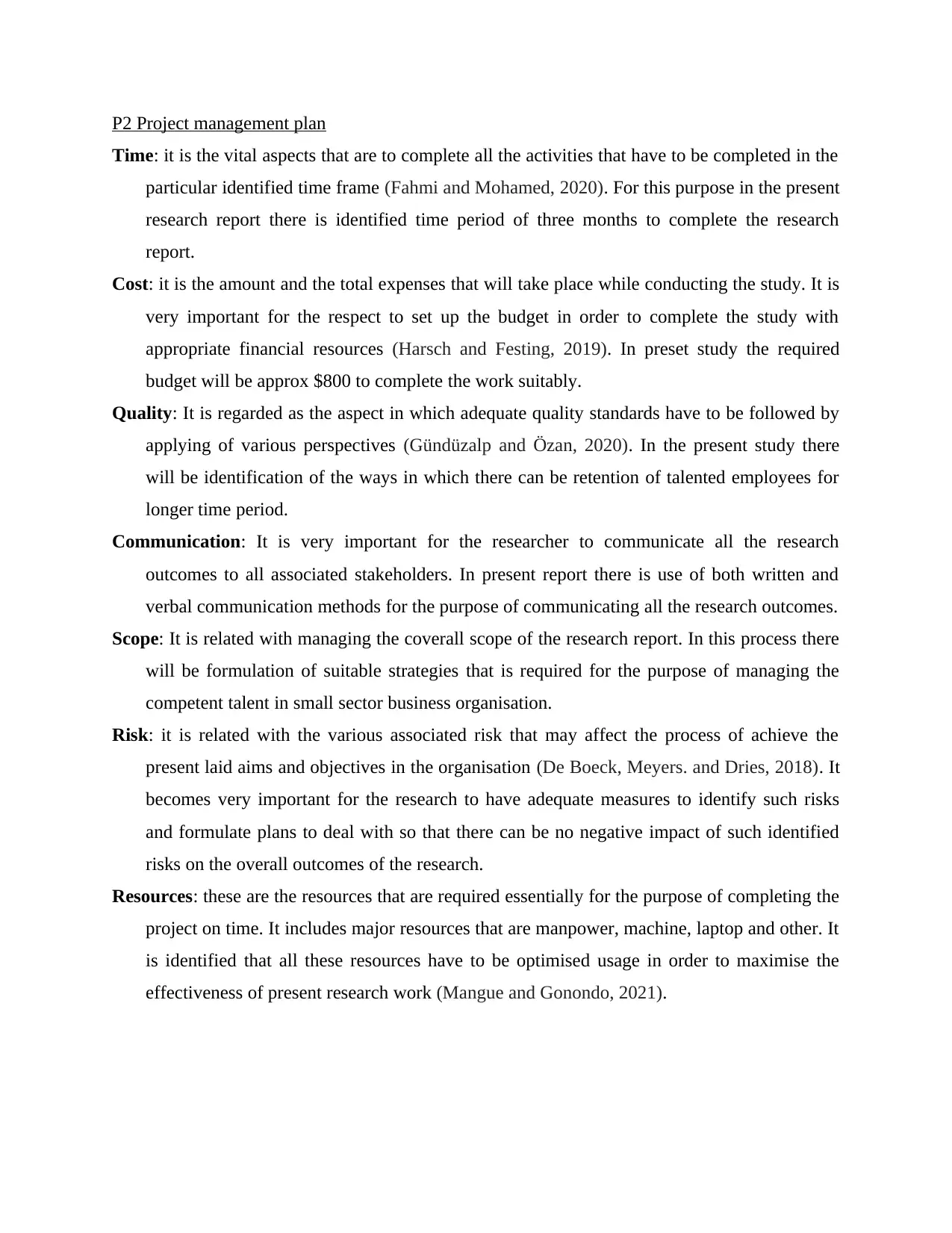
P2 Project management plan
Time: it is the vital aspects that are to complete all the activities that have to be completed in the
particular identified time frame (Fahmi and Mohamed, 2020). For this purpose in the present
research report there is identified time period of three months to complete the research
report.
Cost: it is the amount and the total expenses that will take place while conducting the study. It is
very important for the respect to set up the budget in order to complete the study with
appropriate financial resources (Harsch and Festing, 2019). In preset study the required
budget will be approx $800 to complete the work suitably.
Quality: It is regarded as the aspect in which adequate quality standards have to be followed by
applying of various perspectives (Gündüzalp and Özan, 2020). In the present study there
will be identification of the ways in which there can be retention of talented employees for
longer time period.
Communication: It is very important for the researcher to communicate all the research
outcomes to all associated stakeholders. In present report there is use of both written and
verbal communication methods for the purpose of communicating all the research outcomes.
Scope: It is related with managing the coverall scope of the research report. In this process there
will be formulation of suitable strategies that is required for the purpose of managing the
competent talent in small sector business organisation.
Risk: it is related with the various associated risk that may affect the process of achieve the
present laid aims and objectives in the organisation (De Boeck, Meyers. and Dries, 2018). It
becomes very important for the research to have adequate measures to identify such risks
and formulate plans to deal with so that there can be no negative impact of such identified
risks on the overall outcomes of the research.
Resources: these are the resources that are required essentially for the purpose of completing the
project on time. It includes major resources that are manpower, machine, laptop and other. It
is identified that all these resources have to be optimised usage in order to maximise the
effectiveness of present research work (Mangue and Gonondo, 2021).
Time: it is the vital aspects that are to complete all the activities that have to be completed in the
particular identified time frame (Fahmi and Mohamed, 2020). For this purpose in the present
research report there is identified time period of three months to complete the research
report.
Cost: it is the amount and the total expenses that will take place while conducting the study. It is
very important for the respect to set up the budget in order to complete the study with
appropriate financial resources (Harsch and Festing, 2019). In preset study the required
budget will be approx $800 to complete the work suitably.
Quality: It is regarded as the aspect in which adequate quality standards have to be followed by
applying of various perspectives (Gündüzalp and Özan, 2020). In the present study there
will be identification of the ways in which there can be retention of talented employees for
longer time period.
Communication: It is very important for the researcher to communicate all the research
outcomes to all associated stakeholders. In present report there is use of both written and
verbal communication methods for the purpose of communicating all the research outcomes.
Scope: It is related with managing the coverall scope of the research report. In this process there
will be formulation of suitable strategies that is required for the purpose of managing the
competent talent in small sector business organisation.
Risk: it is related with the various associated risk that may affect the process of achieve the
present laid aims and objectives in the organisation (De Boeck, Meyers. and Dries, 2018). It
becomes very important for the research to have adequate measures to identify such risks
and formulate plans to deal with so that there can be no negative impact of such identified
risks on the overall outcomes of the research.
Resources: these are the resources that are required essentially for the purpose of completing the
project on time. It includes major resources that are manpower, machine, laptop and other. It
is identified that all these resources have to be optimised usage in order to maximise the
effectiveness of present research work (Mangue and Gonondo, 2021).
Paraphrase This Document
Need a fresh take? Get an instant paraphrase of this document with our AI Paraphraser
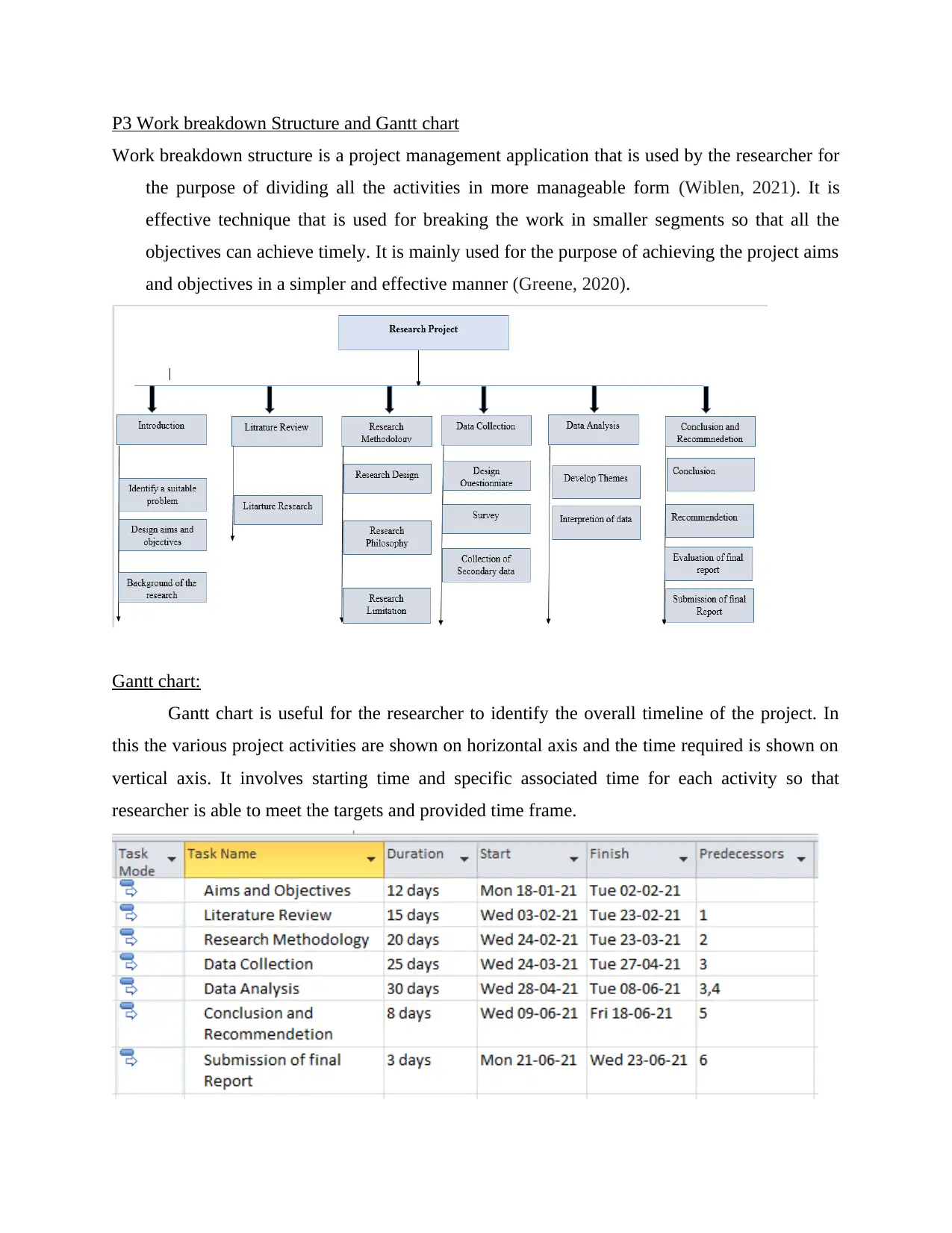
P3 Work breakdown Structure and Gantt chart
Work breakdown structure is a project management application that is used by the researcher for
the purpose of dividing all the activities in more manageable form (Wiblen, 2021). It is
effective technique that is used for breaking the work in smaller segments so that all the
objectives can achieve timely. It is mainly used for the purpose of achieving the project aims
and objectives in a simpler and effective manner (Greene, 2020).
Gantt chart:
Gantt chart is useful for the researcher to identify the overall timeline of the project. In
this the various project activities are shown on horizontal axis and the time required is shown on
vertical axis. It involves starting time and specific associated time for each activity so that
researcher is able to meet the targets and provided time frame.
Work breakdown structure is a project management application that is used by the researcher for
the purpose of dividing all the activities in more manageable form (Wiblen, 2021). It is
effective technique that is used for breaking the work in smaller segments so that all the
objectives can achieve timely. It is mainly used for the purpose of achieving the project aims
and objectives in a simpler and effective manner (Greene, 2020).
Gantt chart:
Gantt chart is useful for the researcher to identify the overall timeline of the project. In
this the various project activities are shown on horizontal axis and the time required is shown on
vertical axis. It involves starting time and specific associated time for each activity so that
researcher is able to meet the targets and provided time frame.
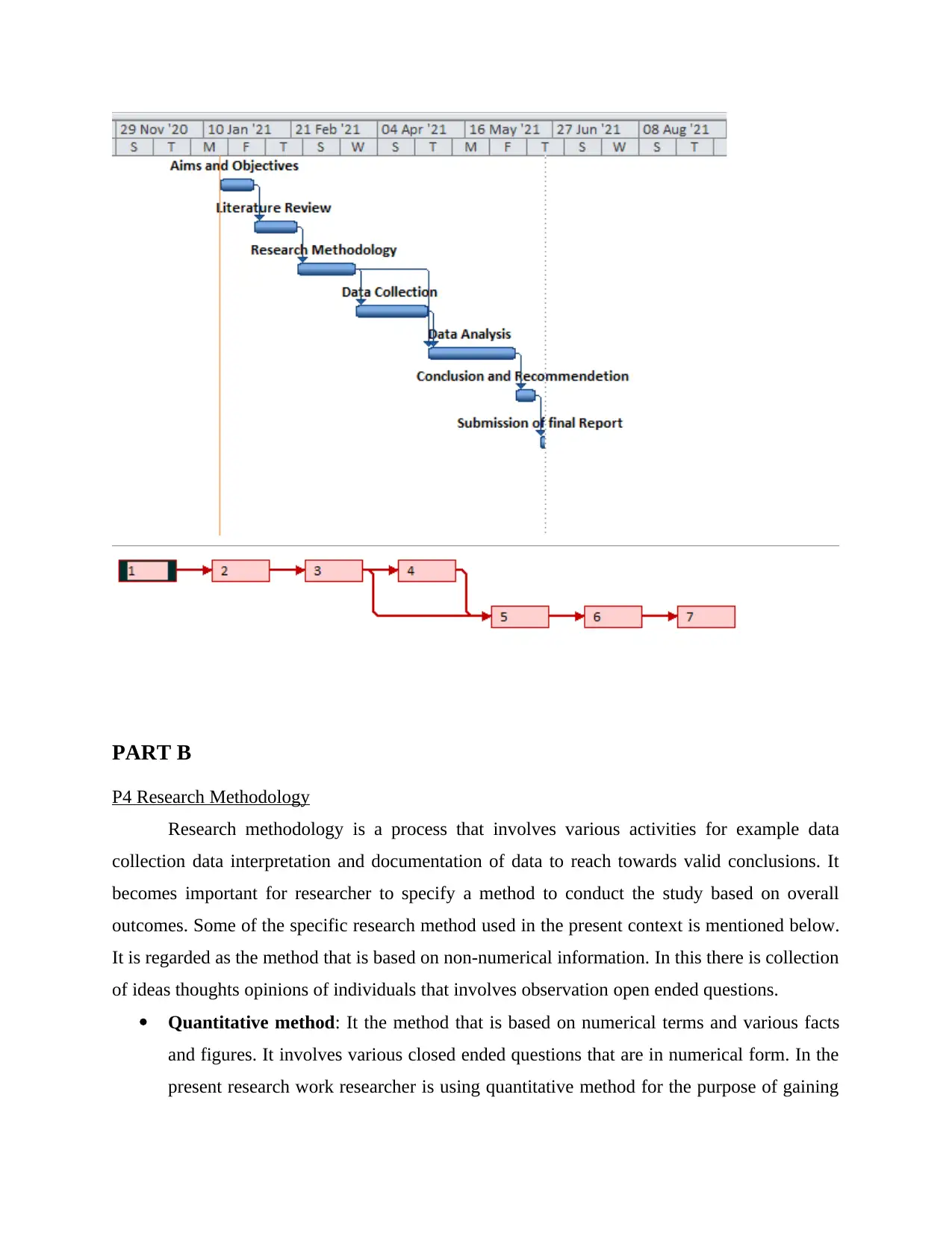
PART B
P4 Research Methodology
Research methodology is a process that involves various activities for example data
collection data interpretation and documentation of data to reach towards valid conclusions. It
becomes important for researcher to specify a method to conduct the study based on overall
outcomes. Some of the specific research method used in the present context is mentioned below.
It is regarded as the method that is based on non-numerical information. In this there is collection
of ideas thoughts opinions of individuals that involves observation open ended questions.
Quantitative method: It the method that is based on numerical terms and various facts
and figures. It involves various closed ended questions that are in numerical form. In the
present research work researcher is using quantitative method for the purpose of gaining
P4 Research Methodology
Research methodology is a process that involves various activities for example data
collection data interpretation and documentation of data to reach towards valid conclusions. It
becomes important for researcher to specify a method to conduct the study based on overall
outcomes. Some of the specific research method used in the present context is mentioned below.
It is regarded as the method that is based on non-numerical information. In this there is collection
of ideas thoughts opinions of individuals that involves observation open ended questions.
Quantitative method: It the method that is based on numerical terms and various facts
and figures. It involves various closed ended questions that are in numerical form. In the
present research work researcher is using quantitative method for the purpose of gaining
⊘ This is a preview!⊘
Do you want full access?
Subscribe today to unlock all pages.

Trusted by 1+ million students worldwide
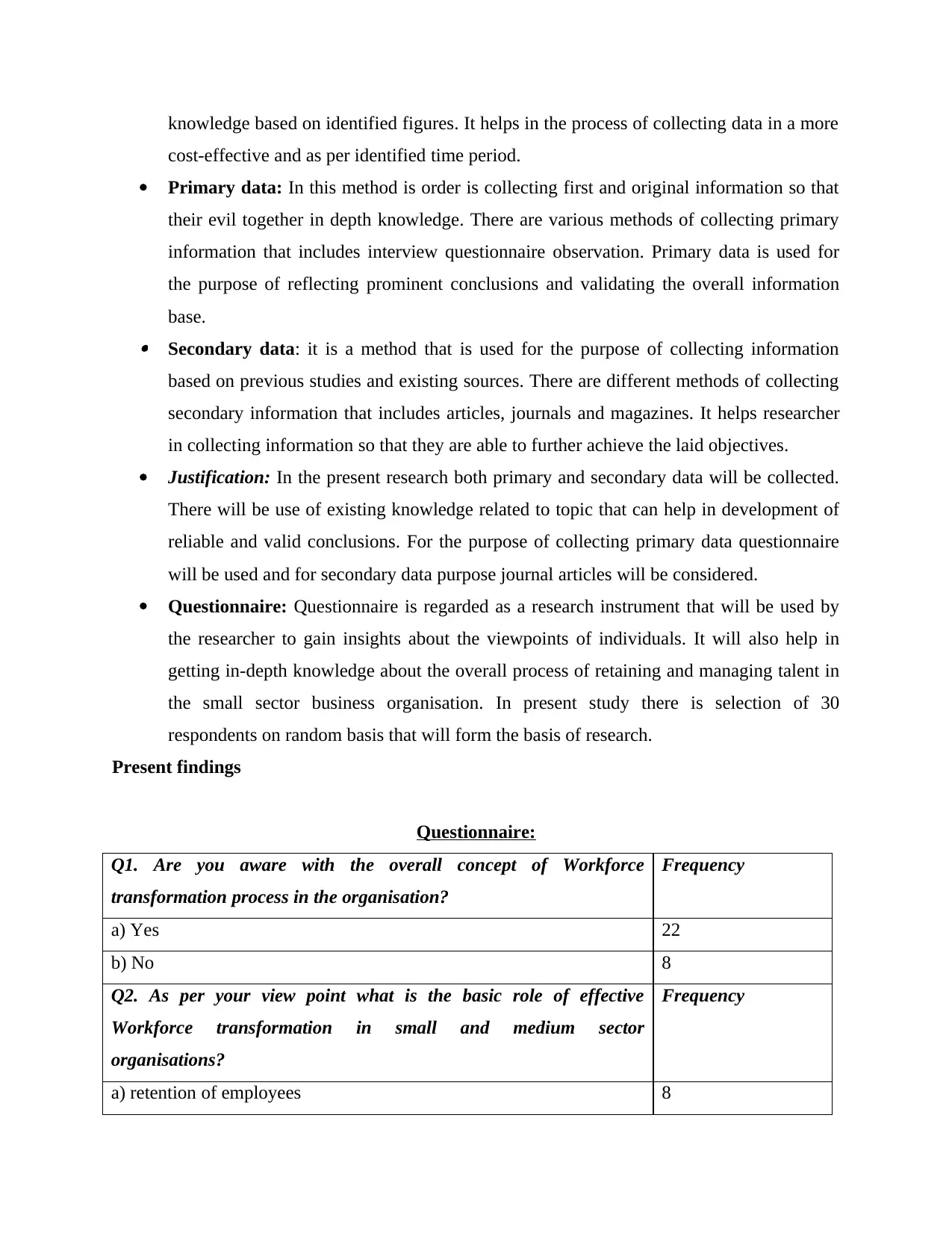
knowledge based on identified figures. It helps in the process of collecting data in a more
cost-effective and as per identified time period.
Primary data: In this method is order is collecting first and original information so that
their evil together in depth knowledge. There are various methods of collecting primary
information that includes interview questionnaire observation. Primary data is used for
the purpose of reflecting prominent conclusions and validating the overall information
base. Secondary data: it is a method that is used for the purpose of collecting information
based on previous studies and existing sources. There are different methods of collecting
secondary information that includes articles, journals and magazines. It helps researcher
in collecting information so that they are able to further achieve the laid objectives.
Justification: In the present research both primary and secondary data will be collected.
There will be use of existing knowledge related to topic that can help in development of
reliable and valid conclusions. For the purpose of collecting primary data questionnaire
will be used and for secondary data purpose journal articles will be considered.
Questionnaire: Questionnaire is regarded as a research instrument that will be used by
the researcher to gain insights about the viewpoints of individuals. It will also help in
getting in-depth knowledge about the overall process of retaining and managing talent in
the small sector business organisation. In present study there is selection of 30
respondents on random basis that will form the basis of research.
Present findings
Questionnaire:
Q1. Are you aware with the overall concept of Workforce
transformation process in the organisation?
Frequency
a) Yes 22
b) No 8
Q2. As per your view point what is the basic role of effective
Workforce transformation in small and medium sector
organisations?
Frequency
a) retention of employees 8
cost-effective and as per identified time period.
Primary data: In this method is order is collecting first and original information so that
their evil together in depth knowledge. There are various methods of collecting primary
information that includes interview questionnaire observation. Primary data is used for
the purpose of reflecting prominent conclusions and validating the overall information
base. Secondary data: it is a method that is used for the purpose of collecting information
based on previous studies and existing sources. There are different methods of collecting
secondary information that includes articles, journals and magazines. It helps researcher
in collecting information so that they are able to further achieve the laid objectives.
Justification: In the present research both primary and secondary data will be collected.
There will be use of existing knowledge related to topic that can help in development of
reliable and valid conclusions. For the purpose of collecting primary data questionnaire
will be used and for secondary data purpose journal articles will be considered.
Questionnaire: Questionnaire is regarded as a research instrument that will be used by
the researcher to gain insights about the viewpoints of individuals. It will also help in
getting in-depth knowledge about the overall process of retaining and managing talent in
the small sector business organisation. In present study there is selection of 30
respondents on random basis that will form the basis of research.
Present findings
Questionnaire:
Q1. Are you aware with the overall concept of Workforce
transformation process in the organisation?
Frequency
a) Yes 22
b) No 8
Q2. As per your view point what is the basic role of effective
Workforce transformation in small and medium sector
organisations?
Frequency
a) retention of employees 8
Paraphrase This Document
Need a fresh take? Get an instant paraphrase of this document with our AI Paraphraser
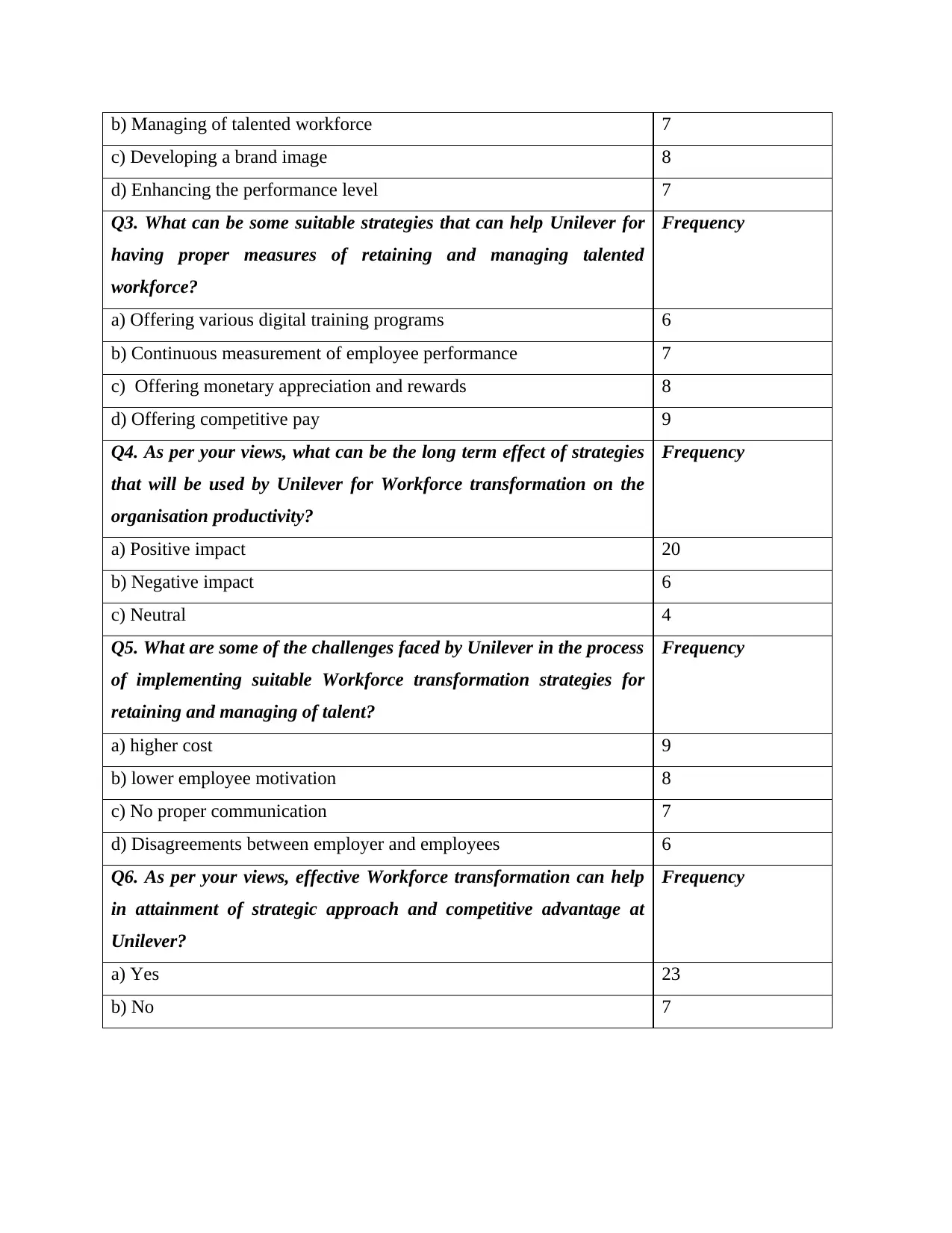
b) Managing of talented workforce 7
c) Developing a brand image 8
d) Enhancing the performance level 7
Q3. What can be some suitable strategies that can help Unilever for
having proper measures of retaining and managing talented
workforce?
Frequency
a) Offering various digital training programs 6
b) Continuous measurement of employee performance 7
c) Offering monetary appreciation and rewards 8
d) Offering competitive pay 9
Q4. As per your views, what can be the long term effect of strategies
that will be used by Unilever for Workforce transformation on the
organisation productivity?
Frequency
a) Positive impact 20
b) Negative impact 6
c) Neutral 4
Q5. What are some of the challenges faced by Unilever in the process
of implementing suitable Workforce transformation strategies for
retaining and managing of talent?
Frequency
a) higher cost 9
b) lower employee motivation 8
c) No proper communication 7
d) Disagreements between employer and employees 6
Q6. As per your views, effective Workforce transformation can help
in attainment of strategic approach and competitive advantage at
Unilever?
Frequency
a) Yes 23
b) No 7
c) Developing a brand image 8
d) Enhancing the performance level 7
Q3. What can be some suitable strategies that can help Unilever for
having proper measures of retaining and managing talented
workforce?
Frequency
a) Offering various digital training programs 6
b) Continuous measurement of employee performance 7
c) Offering monetary appreciation and rewards 8
d) Offering competitive pay 9
Q4. As per your views, what can be the long term effect of strategies
that will be used by Unilever for Workforce transformation on the
organisation productivity?
Frequency
a) Positive impact 20
b) Negative impact 6
c) Neutral 4
Q5. What are some of the challenges faced by Unilever in the process
of implementing suitable Workforce transformation strategies for
retaining and managing of talent?
Frequency
a) higher cost 9
b) lower employee motivation 8
c) No proper communication 7
d) Disagreements between employer and employees 6
Q6. As per your views, effective Workforce transformation can help
in attainment of strategic approach and competitive advantage at
Unilever?
Frequency
a) Yes 23
b) No 7
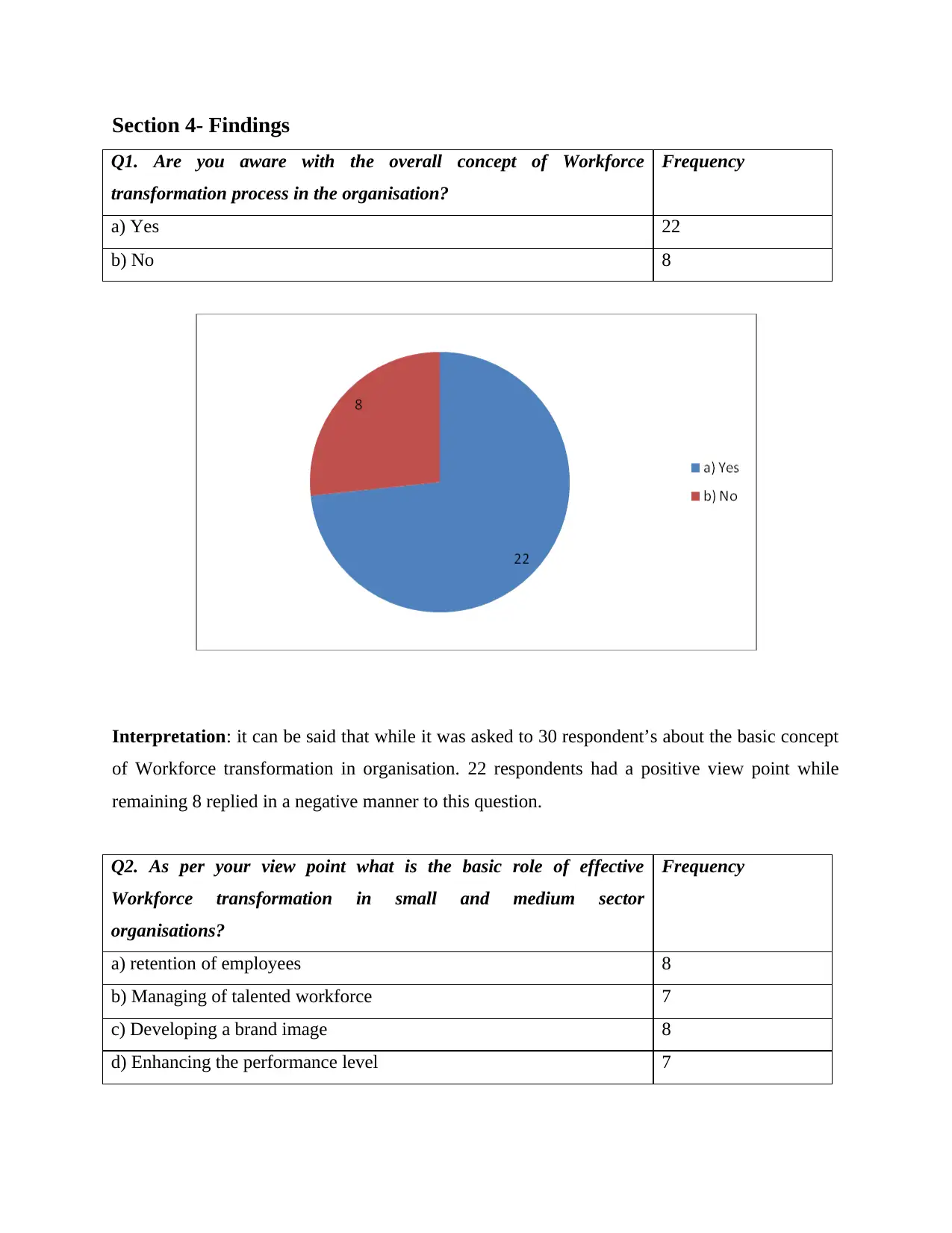
Section 4- Findings
Q1. Are you aware with the overall concept of Workforce
transformation process in the organisation?
Frequency
a) Yes 22
b) No 8
Interpretation: it can be said that while it was asked to 30 respondent’s about the basic concept
of Workforce transformation in organisation. 22 respondents had a positive view point while
remaining 8 replied in a negative manner to this question.
Q2. As per your view point what is the basic role of effective
Workforce transformation in small and medium sector
organisations?
Frequency
a) retention of employees 8
b) Managing of talented workforce 7
c) Developing a brand image 8
d) Enhancing the performance level 7
Q1. Are you aware with the overall concept of Workforce
transformation process in the organisation?
Frequency
a) Yes 22
b) No 8
Interpretation: it can be said that while it was asked to 30 respondent’s about the basic concept
of Workforce transformation in organisation. 22 respondents had a positive view point while
remaining 8 replied in a negative manner to this question.
Q2. As per your view point what is the basic role of effective
Workforce transformation in small and medium sector
organisations?
Frequency
a) retention of employees 8
b) Managing of talented workforce 7
c) Developing a brand image 8
d) Enhancing the performance level 7
⊘ This is a preview!⊘
Do you want full access?
Subscribe today to unlock all pages.

Trusted by 1+ million students worldwide
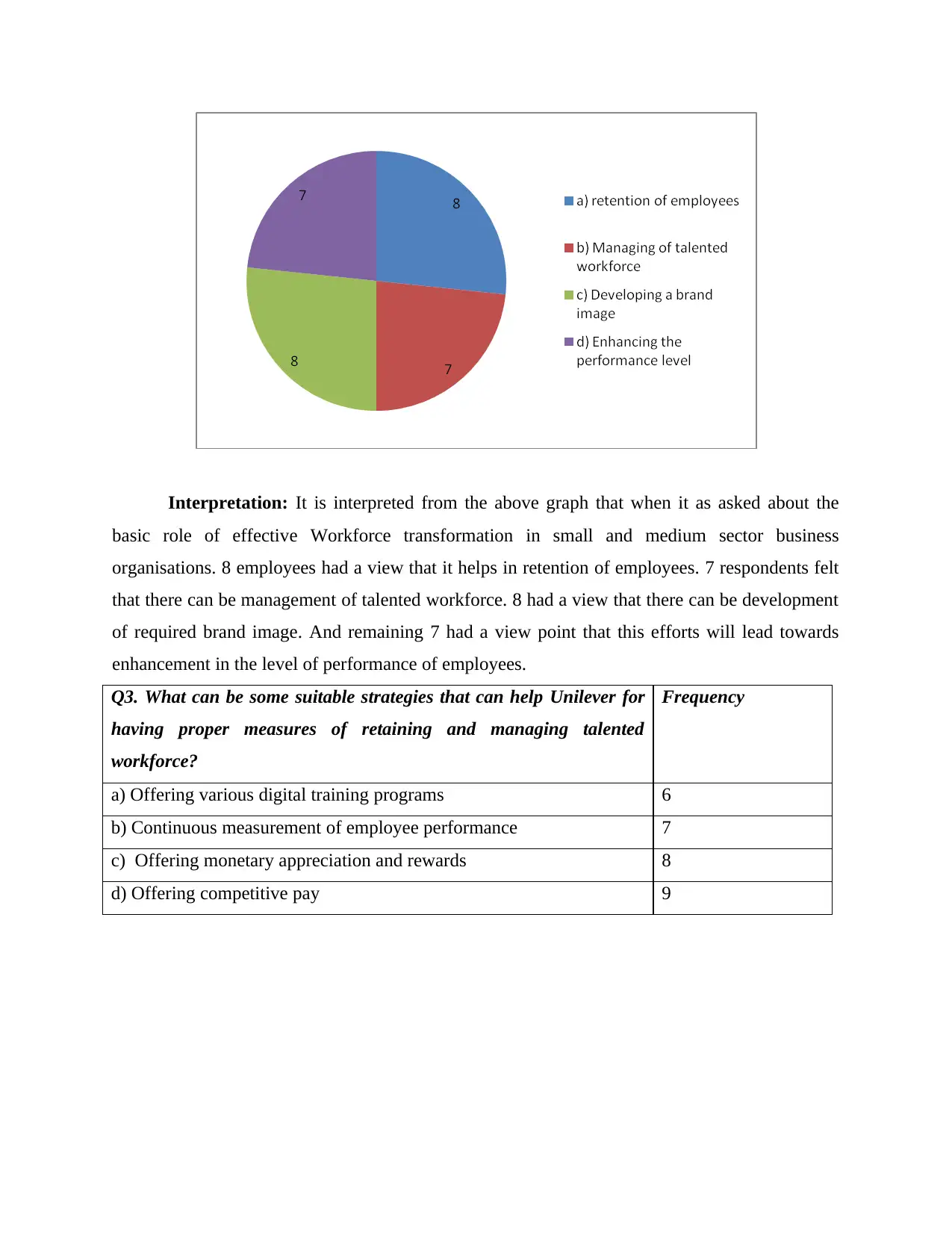
Interpretation: It is interpreted from the above graph that when it as asked about the
basic role of effective Workforce transformation in small and medium sector business
organisations. 8 employees had a view that it helps in retention of employees. 7 respondents felt
that there can be management of talented workforce. 8 had a view that there can be development
of required brand image. And remaining 7 had a view point that this efforts will lead towards
enhancement in the level of performance of employees.
Q3. What can be some suitable strategies that can help Unilever for
having proper measures of retaining and managing talented
workforce?
Frequency
a) Offering various digital training programs 6
b) Continuous measurement of employee performance 7
c) Offering monetary appreciation and rewards 8
d) Offering competitive pay 9
basic role of effective Workforce transformation in small and medium sector business
organisations. 8 employees had a view that it helps in retention of employees. 7 respondents felt
that there can be management of talented workforce. 8 had a view that there can be development
of required brand image. And remaining 7 had a view point that this efforts will lead towards
enhancement in the level of performance of employees.
Q3. What can be some suitable strategies that can help Unilever for
having proper measures of retaining and managing talented
workforce?
Frequency
a) Offering various digital training programs 6
b) Continuous measurement of employee performance 7
c) Offering monetary appreciation and rewards 8
d) Offering competitive pay 9
Paraphrase This Document
Need a fresh take? Get an instant paraphrase of this document with our AI Paraphraser
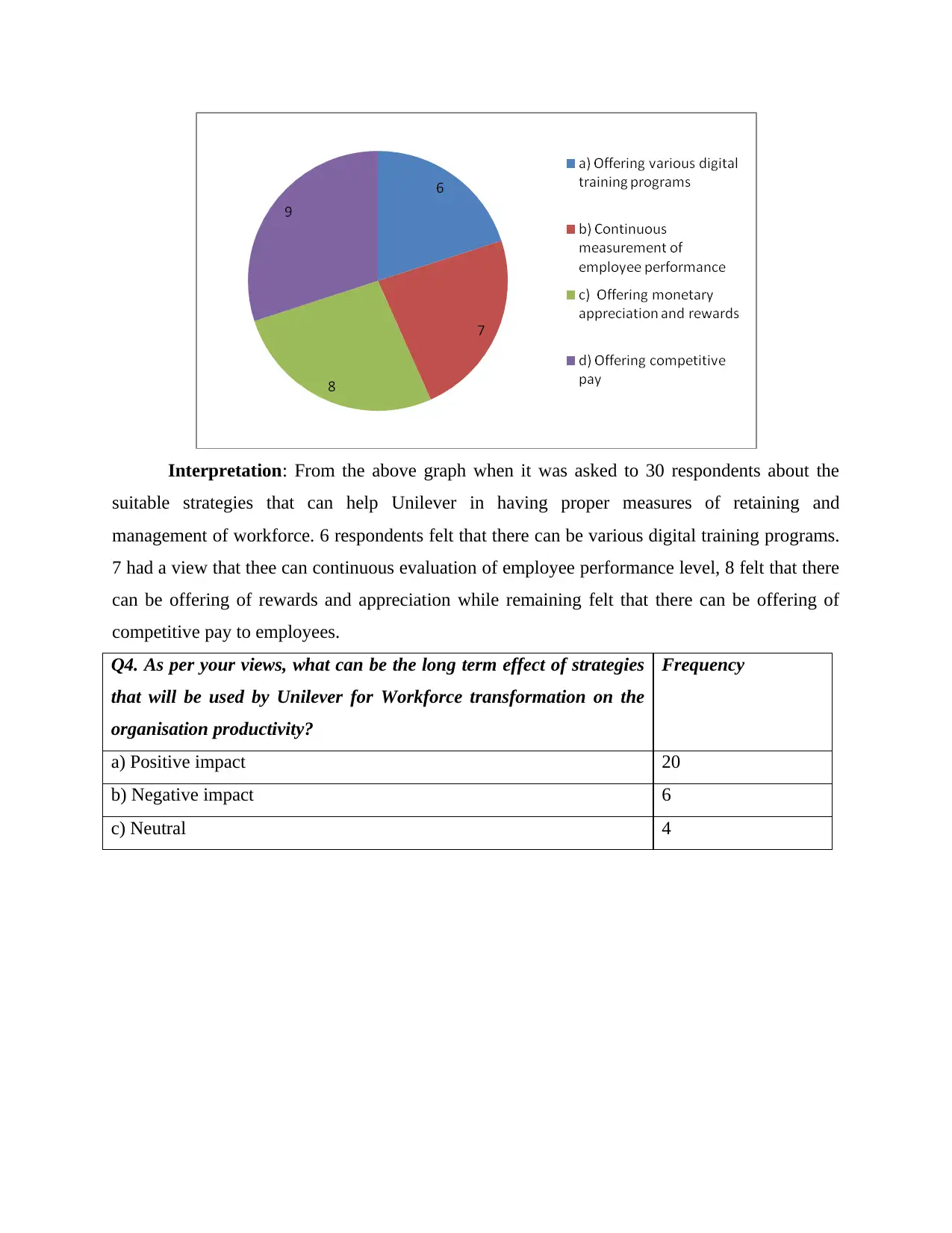
Interpretation: From the above graph when it was asked to 30 respondents about the
suitable strategies that can help Unilever in having proper measures of retaining and
management of workforce. 6 respondents felt that there can be various digital training programs.
7 had a view that thee can continuous evaluation of employee performance level, 8 felt that there
can be offering of rewards and appreciation while remaining felt that there can be offering of
competitive pay to employees.
Q4. As per your views, what can be the long term effect of strategies
that will be used by Unilever for Workforce transformation on the
organisation productivity?
Frequency
a) Positive impact 20
b) Negative impact 6
c) Neutral 4
suitable strategies that can help Unilever in having proper measures of retaining and
management of workforce. 6 respondents felt that there can be various digital training programs.
7 had a view that thee can continuous evaluation of employee performance level, 8 felt that there
can be offering of rewards and appreciation while remaining felt that there can be offering of
competitive pay to employees.
Q4. As per your views, what can be the long term effect of strategies
that will be used by Unilever for Workforce transformation on the
organisation productivity?
Frequency
a) Positive impact 20
b) Negative impact 6
c) Neutral 4
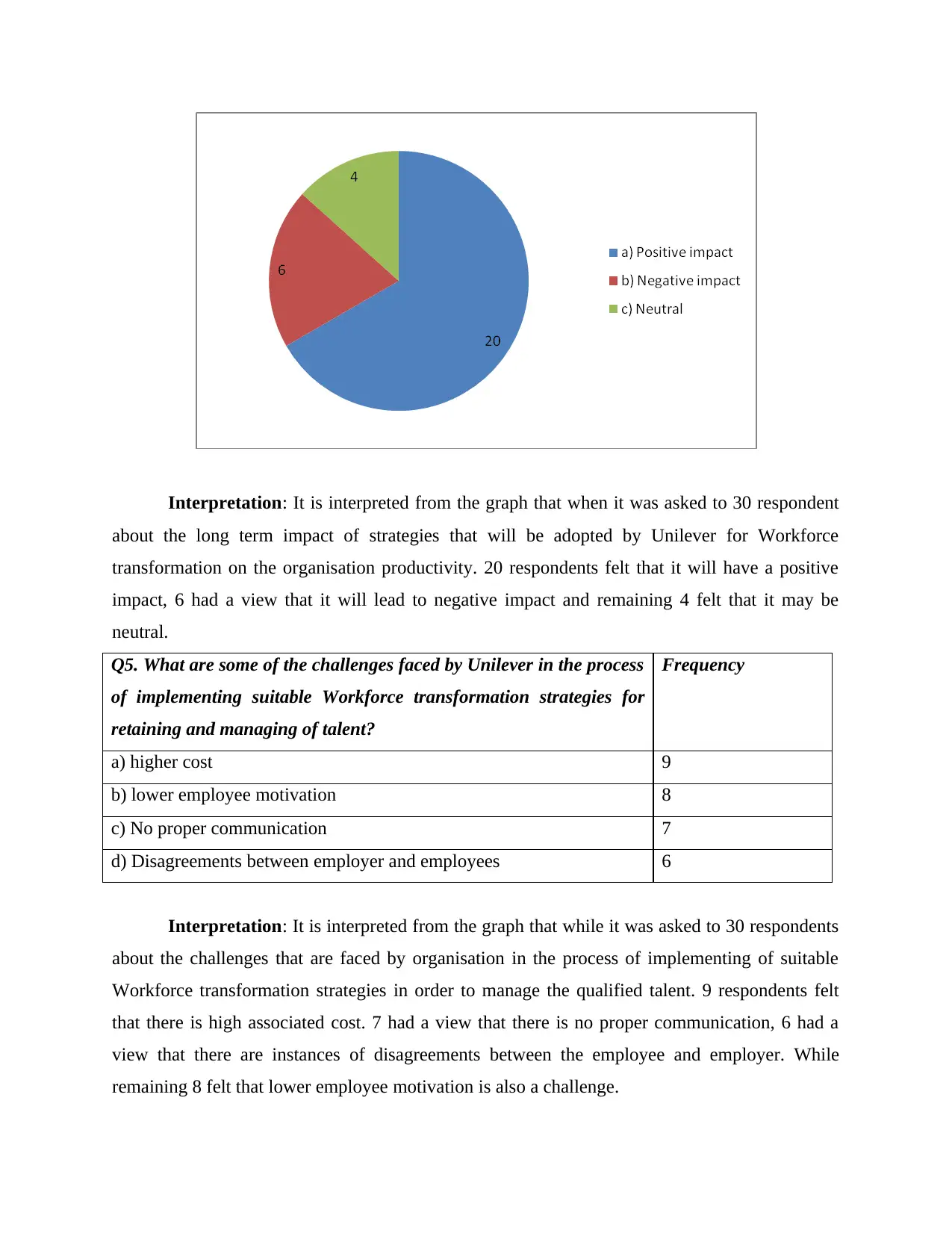
Interpretation: It is interpreted from the graph that when it was asked to 30 respondent
about the long term impact of strategies that will be adopted by Unilever for Workforce
transformation on the organisation productivity. 20 respondents felt that it will have a positive
impact, 6 had a view that it will lead to negative impact and remaining 4 felt that it may be
neutral.
Q5. What are some of the challenges faced by Unilever in the process
of implementing suitable Workforce transformation strategies for
retaining and managing of talent?
Frequency
a) higher cost 9
b) lower employee motivation 8
c) No proper communication 7
d) Disagreements between employer and employees 6
Interpretation: It is interpreted from the graph that while it was asked to 30 respondents
about the challenges that are faced by organisation in the process of implementing of suitable
Workforce transformation strategies in order to manage the qualified talent. 9 respondents felt
that there is high associated cost. 7 had a view that there is no proper communication, 6 had a
view that there are instances of disagreements between the employee and employer. While
remaining 8 felt that lower employee motivation is also a challenge.
about the long term impact of strategies that will be adopted by Unilever for Workforce
transformation on the organisation productivity. 20 respondents felt that it will have a positive
impact, 6 had a view that it will lead to negative impact and remaining 4 felt that it may be
neutral.
Q5. What are some of the challenges faced by Unilever in the process
of implementing suitable Workforce transformation strategies for
retaining and managing of talent?
Frequency
a) higher cost 9
b) lower employee motivation 8
c) No proper communication 7
d) Disagreements between employer and employees 6
Interpretation: It is interpreted from the graph that while it was asked to 30 respondents
about the challenges that are faced by organisation in the process of implementing of suitable
Workforce transformation strategies in order to manage the qualified talent. 9 respondents felt
that there is high associated cost. 7 had a view that there is no proper communication, 6 had a
view that there are instances of disagreements between the employee and employer. While
remaining 8 felt that lower employee motivation is also a challenge.
⊘ This is a preview!⊘
Do you want full access?
Subscribe today to unlock all pages.

Trusted by 1+ million students worldwide
1 out of 20
Related Documents
Your All-in-One AI-Powered Toolkit for Academic Success.
+13062052269
info@desklib.com
Available 24*7 on WhatsApp / Email
![[object Object]](/_next/static/media/star-bottom.7253800d.svg)
Unlock your academic potential
Copyright © 2020–2025 A2Z Services. All Rights Reserved. Developed and managed by ZUCOL.




